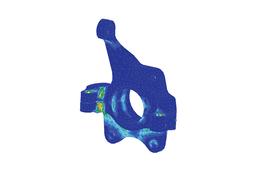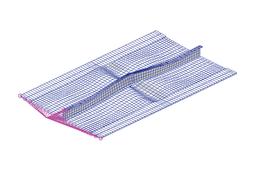
Multidiscipline Simulation Software Supplier, Linear and Nonlinear Finite Element Analysis (FEA), Control Systems Simulation and more
Integrated Fatigue Simulation
Calculate fatigue damage and life within MSC Nastran, and optimize product designs for weight and durability.
Most structural systems undergo cyclic loads during their service life and designers need to design them to ensure they do not fail early in life. Fatigue or durability studies are a critical part of product development, as early failures could raise warranty costs and loss of market share. While fatigue analysis is generally recognized as a key element of design, it is often done in either on ad hoc basis or in an inefficient sequential manner, with stress analysis followed by a durability analysis, adding to the development time and cost. Use of multiple products further adds to cost and analysis time.
MSC Nastran Embedded Fatigue (NEF) is an innovative durability analysis module that features the integration of fatigue calculations within MSC Nastran. In effect, stress and fatigue calculations can occur in one simultaneous operation. This is a significant step forward from GUI based fatigue processes, where fatigue studies are performed after stress studies are complete, and often by different analysis groups, and offers engineers a wealth of new opportunities to improve the life of products. Capabilities include:
- Stress life (S-N)
- Strain life (E-N)
- Multi-axial responses processed using the Critical Plane method
- Parallel processing up to 100 threads
- Multiple fatigue analysis in a single job submission
Capabilities:
Perform Fatigue Analysis Faster

There are numerous reasons why fatigue analysis is faster with NEF, but 2 of the most notable are listed below:
- The traditional approach involves taking FEA results, then transferring, and submitting them to a fatigue program. This approach unfortunately has an impact on solution performance, with need for large amount of computational resources and analyst time. With NEF, the fatigue calculation occurs immediately within the FEA analysis, which saves time and effort required, improving analysis efficiency. In one example, the traditional fatigue analysis process took 8 hours, but with NEF, the analysis took 38 minutes. [Source]
- Since the fatigue calculation occurs in MSC Nastran, the high cost and time needed to move numerous intermediate files between FEA and fatigue program is reduced. This simplification of durability analysis leads to savings of computational resources, resulting in additional simulation capacity and higher productivity. In one example, the fatigue analysis involved 191 files, but with NEF, the number of files involved was just 2. [Source p.62]
Optimize Product Life, Reduce Product Weight


Minimizing the mass of a product, while obtaining a desired fatigue life, is more feasible with NEF. The support of fatigue calculations within MSC Nastran extends into Design Optimization (SOL 200). Models may now be optimized while taking into account fatigue life and other performance criteria such as mass. If the need to consider and optimize multiple models exists, the multi-model optimization capabilities in MSC Nastran may also be utilized. This provides a truly optimized model that can be used faster, without the need for verification of the designs after design optimization analysis.
































